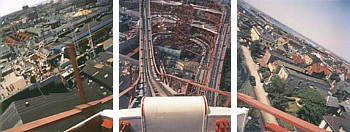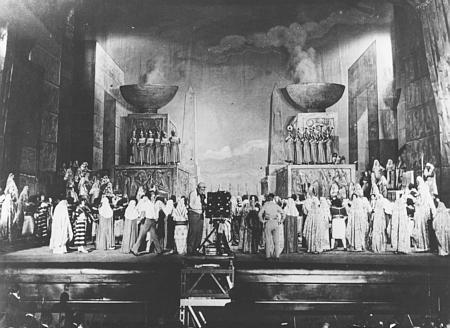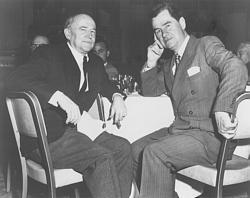|
| cinerama |
|
 Possessed of what can most
tactfully be called a bravura
personality, Todd bullied and
charmed his way across Europe.
Ever the showman with an eye for
the spectacular, he photographed
the Edinburgh Military Tattoo, a
Venice canal boat parade, a
Spanish bullfight (but thankfully
not the final coup de grâce) and
the Act II finale of Aida at La
Scala, the first time cameras had
every been allowed inside the
venerable opera house in Milan. A
few phone calls in Vienna turned
up enough of the famous Boy’s
Choir to sing The Blue Danube
Waltz for the huge camera.
Possessed of what can most
tactfully be called a bravura
personality, Todd bullied and
charmed his way across Europe.
Ever the showman with an eye for
the spectacular, he photographed
the Edinburgh Military Tattoo, a
Venice canal boat parade, a
Spanish bullfight (but thankfully
not the final coup de grâce) and
the Act II finale of Aida at La
Scala, the first time cameras had
every been allowed inside the
venerable opera house in Milan. A
few phone calls in Vienna turned
up enough of the famous Boy’s
Choir to sing The Blue Danube
Waltz for the huge camera.
 The footage, sent to NY for
processing and so unseen by the
crew, created a sensation back at
corporate headquarters. But the
board of directors was not happy
with Todd’s assumption that he
knew best in all matters and it was
becoming hard to attract more
financing because, as Lowell
Thomas candidly writes, “Wall
Street hated Mike Todd.” So he
was quietly bought out and left the
company, happily taking his
money and developing Todd-AO,
the 30 fps 70mm system with the
huge bug-eye lens, which was
designed to be, as he had
stipulated, “Cinerama out of one
hole.” His first production?
Oklahoma!
The footage, sent to NY for
processing and so unseen by the
crew, created a sensation back at
corporate headquarters. But the
board of directors was not happy
with Todd’s assumption that he
knew best in all matters and it was
becoming hard to attract more
financing because, as Lowell
Thomas candidly writes, “Wall
Street hated Mike Todd.” So he
was quietly bought out and left the
company, happily taking his
money and developing Todd-AO,
the 30 fps 70mm system with the
huge bug-eye lens, which was
designed to be, as he had
stipulated, “Cinerama out of one
hole.” His first production?
Oklahoma!
This left the board with just over
an hour of great footage – but no
movie. Cinerama needed another
friend. Quickly.
Enter the Veteran
In a business known for its larger-than-
life personalities, few stand
taller than Merion C. Cooper. A
life-long adventurer in the 19th
century fashion, he resigned from
the Naval Academy in his senior
year, and shipped out as an able
seaman intending to get to Britain
and join the Air Corps during
WWI. Passport problems sent him
back to the States where he joined
the Georgia National Guard and
chased Pancho Villa across
Mexico.
He finally got his chance to fly
when the US entered the war, but
in 1918 he was shot down behind
enemy lines and spent the rest of
the war in a prison camp, where
his severe facial burns were
excellently repaired by German
plastic surgeons. The next year he
joined the Polish Army to help
them resist the Russian invasion,
but was again shot down. He
escaped his Soviet prison after 10
months, and 26 days later, with
the aid of a professional
smuggler, made it to the Latvian
border.
After a short stint as a reporter for
the NY Times, he and cameraman
buddy Ernest Schoedsack hit upon
an idea to combine their two loves
– flying and exploration. They
headed for the Persian Gulf and
spent the next several months with
one of the wandering tribes there
as they sought pasture during the
terrible equatorial summers of the
Middle East. The result was Grass
(1925), a landmark in
documentary film. Two years later,
they released Chang, shot in Siam,
to even greater success.
Brought to RKO by David O.
Selznick to help with production,
Cooper saw some dimensional
animation tests by effects man
Willis O’Brien for the studio’s
unmade Creation. Cooper had no
interest in the project, but was
very interested in O’Brien, whoes
magic with animated model
animals he saw as the answer to a
major production problem on a
giant ape picture he wanted to
make.
Selznick left for MGM in 1933,
and Cooper was appointed Head
Of Production at RKO. His jungle
adventure picture had taken a
year to complete and cost an
astronomical $650,000. But when
released, King Kong was just as
astronomical a success. It played
continuously at Radio City Music
Hall and the Roxy for over a year.
Eventually, Kong would take its
place as one of the greatest
fantasy adventure films ever made
– perhaps the greatest.
Cooper was instrumental in the
early success of 3-strip
Technicolor, and in 1941 re-enlisted
in the Air Force where he
was Chief of Staff for the famous
“Flying Tigers” which flew against
the Japanese – over the
Himalayas. After the war, he
returned to producing, and with
his partner John Ford, made
several pictures, including She
Wore A Yellow Ribbon and The
Quiet Man.
 Without Mike Todd, Lowell Thomas
knew Cinerama needed a new
producer, and he called Cooper,
who agreed to take over
production, direct new material
and personally edit it all into a
releasable film. The board liked
the idea of shooting in Cypress
Gardens (where the Waller-invented
water ski would be
featured) but hated his plan for a
26-minute flight across the
country. And, oh yes, would he
please put the roller coaster at the
end of the film?
Without Mike Todd, Lowell Thomas
knew Cinerama needed a new
producer, and he called Cooper,
who agreed to take over
production, direct new material
and personally edit it all into a
releasable film. The board liked
the idea of shooting in Cypress
Gardens (where the Waller-invented
water ski would be
featured) but hated his plan for a
26-minute flight across the
country. And, oh yes, would he
please put the roller coaster at the
end of the film?
But the board was no match for
the man who had faced enemy
fire, imprisonment and charging
elephants. Cooper got his way,
and the picture was finished –
barely in time.
“Prior to the premier [of This Is
Cinerama]…no one – including
myself – had seen the whole thing
put together. Some wheat field
shots were barely out of the lab in
time for opening night. I only
made the final cut a couple of
hours before the opening.”
The lights dimmed on the
invitation-only black tie audience,
and on the screen, the familiar
face of Lowell Thomas droned on
for 15 minutes about the history of
photography – from a regular
1.33 frame, and in black in white.
Patrons began to wonder if they’d
been had. “Cinerama, so what’s
the big deal?” Suddenly, the
curtains parted – it seemed they
would never stop – until a deeply
curved screen nearly 40’ high and
over 90’ wide was filled with the
Rockaway roller coaster,
introduced by Thomas’ simple,
triumphant, “Ladies and
gentlemen, THIS IS CINERAMA!”
No wonder Fred Waller was
smiling.
The next morning a rave review of
the opening appeared on the front
page of the NY Times, the only
time any film has been so
honored. Executive phones lit up . . . . CONTINUED
page 34 cinema technology - december 2002
|
|